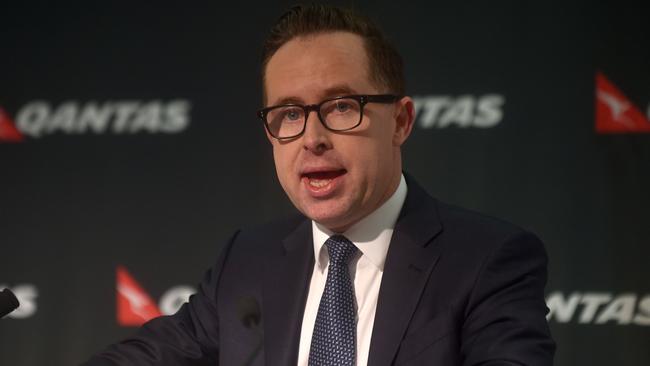Alan Joyce has Qantas clear for take-off again after record profit
Qantas has reported its best financial result in its 95-year history, a $1.52 billion annual profit.

Qantas has reported its best financial result in its 95-year history, as low oil prices, cost cutting and better use of its fleet powered the company to a $1.52 billion annual profit.
The 57 per cent increase in earnings was a far cry from two years ago when Qantas recorded a $2.8bn annual loss and is testament to the turnaround plan of the airline under its chief executive of the past seven years, Alan Joyce.
Lower oil prices, jet-fuel costs and the airline’s world-class hedging strategy boosted earnings during the year by $664 million, but by less in the second half.
Qantas International, which lost $500m in 2014, recorded underlying earnings before interest and tax of $512m in the latest financial year.
The airline’s vaunted alliance with Middle Eastern powerhouse carrier Emirates, once roundly criticised by Mr Joyce’s mentor — former Qantas chief executive Geoff Dixon — is paying handsome dividends. And now there are others with the likes of American Airlines, China Eastern and China Southern.
Investors were rewarded yesterday with a fully franked dividend of 7c a share, the first for several years.
A share buyback program and the return of the dividend means Qantas will have paid back more than $1.5bn to shareholders over the past 18 months.
On the balance sheet, the decision two years ago to write off the value of Qantas’s ageing jumbo jet fleet has also helped to bolster the bottom line by reducing future depreciation charges.
But the most pleasing aspect for Mr Joyce was the result of cost cutting — his so-called transformation of the airline — that generated $557m of benefits in the last financial year. The cost and revenue gains of the program since 2014 are now more than $1.6bn. And there is another $450m to come in the year ahead.
“I knew and the team knew the plan would deliver the results,’’ Mr Joyce, who celebrated his 50th birthday on the last day of the financial year, told The Australian yesterday.
The biggest casualties of the program have been the thousands of staff who have lost their jobs.
“I personally went to the call centres in Melbourne and Brisbane to talk to those amazing staff that were there and it was pretty emotional for everybody. That was the toughest apart of doing this,’’ Mr Joyce said.
“But I always knew that once we had the company back into a stable position, into a profitable position, then we could grow again and that’s what we are doing.
“And now we are hiring pilots, cabin crew, hiring people in our Qantas Loyalty business and recruiting people across the board.
“While that was very tough, what is great now is that the company is back in recruitment mode.’’
The airline used the bumper profit to reward 25,000 non-executive employees who had been subjected to an 18-month pay freeze with $3000 bonuses, totalling $75m. Part timers will get $2500.
Over the past two years Qantas has distributed $160m of cash bonus payments to staff. It’s a far cry from the dark days of 2011 when Mr Joyce stared down the unions and grounded the airline.
Just under 1000 employees were at Mascot in Sydney yesterday to listen to Mr Joyce and Qantas chief financial officer Tino La Spina talk through the numbers.
While their questions in previous years had been about job security and fear, this year they were about the opportunities. About technology. And about the future. International yields are under pressure from capacity growth, the oil price is ticking higher and domestic demand is still weak in the resources sector.
The hard work is still well and truly ahead.




To join the conversation, please log in. Don't have an account? Register
Join the conversation, you are commenting as Logout